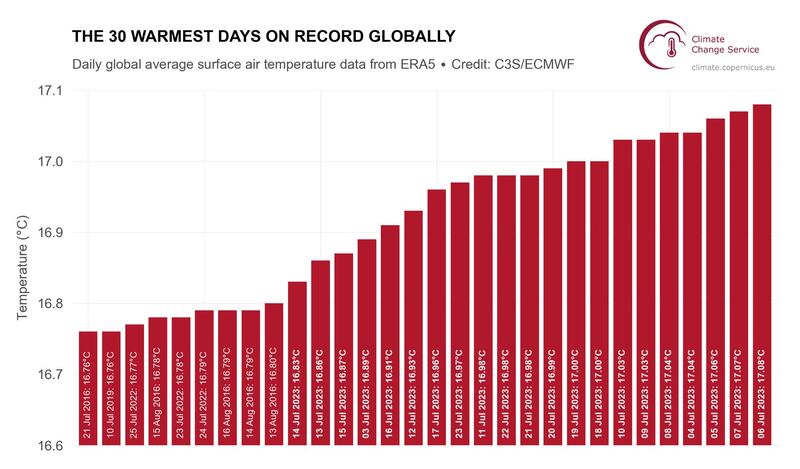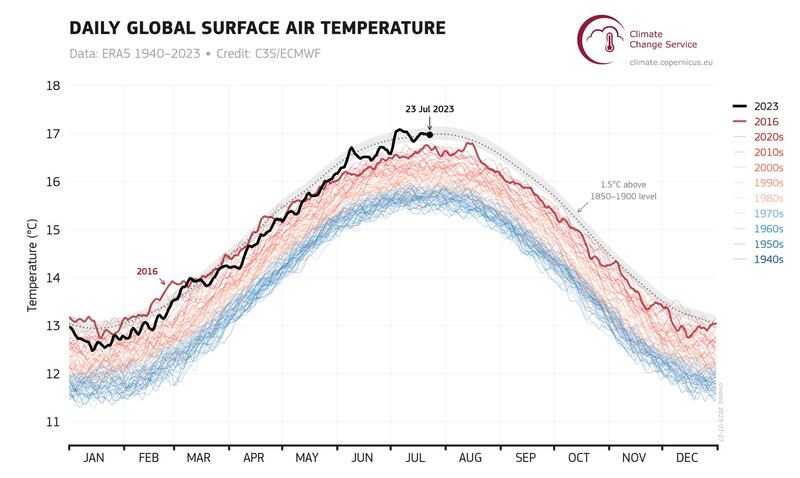The frequency and intensity of extreme weather events, such as droughts and large-scale floods, and other climate change impacts are increasing in Asia, which is warming faster than the global average, the World Meteorological Organization said in a report published Thursday.
Asia is the world's most disaster-impacted region, with 81 weather, climate and water-related disasters recorded last year, killing more than 5,000 people and affecting 50 million, it said in the State of the Climate in Asia 2022 report.
The specialized U.N. agency said most of the calamities were droughts and floods in Asia, the continent with the largest land mass extending to the Arctic.
In 2022, there was more than US$36 billion in economic damage, which significantly exceeded the average for the 2002–2021 period, according to the report.
It said the mean temperature over Asia for 2022 was the second or third warmest on record and was about 0.72 degrees Celsius above the 1991–2020 average.

The organization said that the warming trend experienced in Asia from 1991 to 2022 was nearly twice as high as that observed from 1961 to 1990.
A large part of Asia experienced drier-than-normal conditions, as well as severe dust storms, affecting civil lives in the region, the report said, while China suffered a prolonged drought, which affected the power supply and water availability.
“The estimated economic losses from the drought affecting many regions in China were over US$ 7.6 billion,” said World Meteorological Organization (WMO) Secretary-General Petteri Taalas.
In Pakistan, glacial melt and record monsoon rains killed hundreds of people after it received 60% of its normal total rainfall in just three weeks of the start of the monsoon season in 2022, the report said.
According to the country’s disaster management authority, more than 33 million people, almost 14% of the population, were affected as the country was inundated for months.
The WMO said that most glaciers in Asia’s mountainous belt had significant mass loss due to warm and dry conditions in 2022, with Urumqi Glacier No. 1 in China’s Xinjiang recording the second-highest mass loss since measurements began in 1959.
“This will have major implications for future food and water security and ecosystems,” Taalas said.
The WMO said the region also showed an overall surface ocean warming trend since the time series began in 1982, with the rates in the northwestern Arabian Sea, the Philippine Sea and the seas east of Japan exceeding 0.5 degrees Celsius per decade, about three times faster than the global average.
July to be the hottest month on record
Meanwhile, the initial three weeks of July have set a new record as the hottest three-week period ever recorded, and it appears that this trend will continue, making it not only the warmest July but also the hottest month in recorded history, according to another report by the WMO and the EU-funded Copernicus Climate Change Service.
These temperatures have been associated with heat waves across many areas of North America, Asia, and Europe.

The daily average global mean surface air temperature reached 17.08 degrees Celsius (62.74 degrees Fahrenheit) on July 6, surpassing the record set in August 2016, making it the hottest day on record, with July 5 and 7 shortly behind, according to the two weather organizations.
It is “virtually certain” that July 2023 will be the hottest July and also the hottest month on record, following on from the hottest June on record, they said.
The global mean surface air temperature average for the first 23 days of July 2023 was 16.95 degrees Celsius (62.51 degrees Fahrenheit). The previous record was July 2019 at 16.63 Celsius (61.93 degrees Fahrenheit).
According to the China Meteorological Administration, China’s Turpan City in Xinjiang province set a new national temperature record of 52.2 Celsius (125.96 degrees Fahrenheit) on July 16.
“Record-breaking temperatures are part of the trend of drastic increases in global temperatures. Anthropogenic emissions are ultimately the main driver of these rising temperatures,” said Carlo Buontempo, director of the Copernicus Climate Change Service.
The WMO has predicted a 98% likelihood that at least one of the next five years will be the warmest on record.

Another report on Tuesday said some of the extreme temperatures recorded earlier this month would have been “virtually impossible” without the influence of human-caused climate change.
Climate change increased the likelihood of a heat wave in China by 50 times and made it 1 degree Celsius hotter, according to researchers from World Weather Attribution, an international group of scientists that assesses the impact of climate change on extreme weather events.
Before the industrial revolution, China experienced heat waves like this month about once every 250 years, whereas North American and European heat waves were extremely rare.
“Events like these can now be expected approximately once every 15 years in North America, about once every 10 years in southern Europe, and approximately once every five years in China,” they said.
Edited by Mike Firn.
